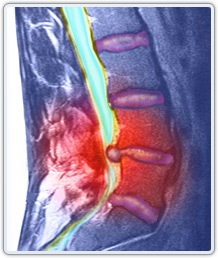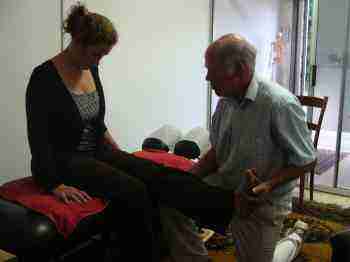Lower back and leg pain exercises
Lower back and leg pain exercises are for the patient with a herniated disc.
These should only be done with your doctor's consent. It is a prerequisite for watching the video. Please, be sensible; severe lumbar pain is a very serious condition. Whilst the vast majority of people get over it, without too much drama, at least with chiropractic, research shows that 5 percent end up under the knife.
This page was last updated by Dr Barrie Lewis on 9th April, 2023.
As a rule of thumb never assume it won't be you. Follow the slipped disc rules and get better; then you and your doctor will both be happy.
Acute severe lower back pain can be very frightening. And the repercussions, if poorly managed, can ruin a person's life; literally.
Each case is unique and should be managed thoughtfully and carefully. In one sense, no two are alike.
Lower back and leg pain exercises
Lower back and leg pain exercises can also be used for those with lumbar stenosis; they should only be done only with your chiropractor's consent.
Tip
If you have slow internet, and frustratingly when watching this video, it stops periodically, with a little wheel spinning in the centre then:
- Just below the video you'll see: // Loudness symbol x/3:27
- Look immediately below the video for the red line following a grey line. If the red line catches up with the grey line, then the video stops.
- Click on the // (it becomes an arrowhead) and wait until the grey line reaches the end. Perhaps a minute.
- Click on the arrowhead. You may have to pull the little circle at the end of the red line to the right to get the video started again.
Lumbar disc syndrome and bed rest
It's perhaps controversial, but I am a firm believer in chiropractic treatment; that means gentle repositioning of the herniated disc using a variety of techniques and a set of exercises; the right ones. They restore the flexibility of the disc and ultimately, later, to strengthen the core muscles.
You may have pain on coughing, sneezing and bearing down on the toilet. Forward bending is virtually always painful in the lower back, and there may be a tightness or frank pain in the naughty leg.
It's agreed by virtually all authorities that extended bed rest for ordinary lower back pain, if there is such at thing, is not helpful, and may in fact aggravate the condition.
But with a slipped disc you may not sit for a few days, and often you are unable to stand for any length of time. So what are you to do?
Bed rest, with cushions under your knees and these lower back and leg pain exercises every 15 to 30 minutes is the solution. Every hour, during the day, get up and walk around for as long as you can.
I call it modified, or massaging bed rest.
These lower back and leg pain exercises take only one minute. You'll find they may hurt a little at first, and sometimes a lot; do them gently. It is okay to feel some discomfort.
In fact if you feel nothing, they may not be achieving much, but they should not cause sharp pain.
If
the herniation is lateral, then both the flexion and extension parts of
the pelvic tilt exercise may be very painful; try doing it then with
your legs flat on your bed.
Then generally the pain starts to lessen as you do the exercises.
Ice
Wrap an ice pack in a tea towel, and put it on your back, probably best lying on your side, for about 30 minutes. Follow it with a hot shower or heated pack for a short time, say ten minutes. Stay out of the bath.
I call it cold-hot therapy.
Getting out of bed
Do not sit up, as you would normally do. Instead, roll onto your side and carefully push yourself up sideways using your elbow and other hand.
Sometimes, if it's really severe, you may not be able to do that. Then roll onto your side, and thence onto your knees on the floor; then carefully first straighten up and slowly stand putting as much weight on the bed as possible.
Oddly lying down from a standing position may be even worse than getting up. You've been walking about for half an hour, because you know it is not good to lie down too much. But now the back is feeling weak and sore, and you cannot sit, so you must go to your bed.
But how
do you do it? I can be excruciating going from a standing to a lying
position. How do I know this? Thirty five years in practice plus I
myself have the T-shirt. I've been there, and done that, myself.
Go down onto one knee on the ground, then the other, and roll onto your bed. Take your time; it may even be five minutes before you can pluck up the courage to get up or lie down. That's okay.
There are obviously many causes of back and leg pain. These exercises are specifically for the lumbar disc syndrome, but they are very gentle and, done sensibly, they are unlikely to aggravate other conditions. Keep in mind you're not trying to reach the Olympic team, just trying to get a little fitter and have less pain.
If it has taken you thirty years to get out of shape, then don't expect to get fit and strong in a few weeks. You will just aggravate the condition and make it worse!
Slipped disc
Slipped disc is described in anatomical terms as a bulge, a protrusion or a prolapse; extrusion and finally a sequestration, with increasing leg pain.
A hole forms in the annulus, through which the disc material slips affecting the nerve roots and even the spinal cord.
After a prolapse like this is reduced, it takes a minimum of six weeks, and probably three months for the annulus to heal; relapse is common should patients start bending and lifting too soon.

If you have a frank disc bulge, then the sooner it's repositioned the better. It may be a terrifying thought, but a chiropractic manipulation in the hands of a skilled practitioner is not particularly painful.
It's absolutely vital, and then to do the lower back and leg pain exercises to prevent a relapse.
Femoral nerve is a mid lumbar structure.
There are two large nerves emanating from the lumbar spine; that from the upper lumbars is called the femoral nerve. It supplies mainly the front of the thigh and the inner lower leg.
The femoral nerve
is motor to the quadriceps muscle, the large muscle in the front of the
thigh that raises the thigh and straightens the knee. If affected you
will develop a pronounced limp and your leg will start giving on
steps.
I have the t-shirt myself. Femoral nerve damage causes severe pain in the upper leg and numbness in the inner lower leg, believe you me. I ain't kidding!
You
have no option but to stop if you want to escape surgery. It is
clinically challenging, but given patience and care you will recover
with chiropractic help.
Help for sciatica pain
Help for sciatica pain is working, but don't expect miracles. Sometimes healing happens spontaneously but in the main pinched nerves require treatment, rest, rehabilitation and patience.
It has one of the highest cost tags for medical insurance companies; chiropractic is far cheaper, a good deal safer, but it's still an expensive business if you go through the process to get properly better.
If you
don't, be it medical or chiropractic care, all that happens is the pain
will start all over again within a few weeks or months, and then you are
back to square one. These lower back and leg pain exercises are an
important part of that process that we glibly call prevention, but often
totally ignore once the pain has gone.
Snakes and ladders is not the way to manage lower back and leg pain; exercises are vital.

The nerve from the lower lumbar spine is called the sciatic nerve; an irritation or impingement causes sciatica, a painful condition affecting the buttock, back of the thigh and lower leg and either the side of the foot, or the area around the great toe.
Try to note as accurately as you can which part of your leg is affected before consulting your chiropractor. Try pricking the leg with a pin, and comparing it with the other leg; just where is it hypersensitive or numb?
There is a simple test you can do at home called the Slump test for sciatica. Sitting in an ordinary kitchen chair, have someone gently straighten first the other knee, and then the naughty leg.
I like to think of five levels of slipped disc:
- Just pain in the back. A bulge.
- Back pain plus tingling, numbness or pain in the leg. A protrusion.
- Back pain plus actually sensory changes in the leg when pricked with a pin. A prolapse.
- Back
pain plus motor weakness; can you lift your great toe, and stand on the
toes? Is your knee buckling. Extrusion into the intervertebral foramen
causes severe leg pain.
- Much less back pain, but severe symptoms and signs in the leg. The sequestrated disc.
Obviously as you progress down the list, you have to take these slipped disc rules increasingly seriously if you want to escape surgery.
Sciatica too is an everyday event at the Chiropractic Coalface, but each case is unique and clinically challenging. If your DC tells you to stop, then stay at home, don't sit and go to bed, doing gentle back exercises and taking short walks around the house every hour.
If you are a smoker, then stop; it's the single most important factor in whether you'll get better or not. That disc and nerve needs all the oxygen it can get to heal. Easier said than done, I know, but perhaps it is a good time to quit permanently.
Smoking knocks on average 7 years off your life, and the end will be nasty.
There's help for sciatica pain, but you also have to help yourself; the pain and disability associated with a slipped disc is not to be underestimated.
It's a generalisation, but sciatica tends to affect the younger person, and the femoral nerve lesion the older patient. All must do lower back and leg pain exercises, or the next episode lies in wait just around the corner.
Once you are well over the crisis, this beginner Ab workout[1] will help you recover your strength; do them every day. Having had a crisis like this, my advice is that lower back and leg pain exercises should continue for life; like you brush your teeth, or a diabetic must walk daily.
Otherwise within a month or two, perhaps longer if you are lucky, it will be back. The cure lies in your hands, not your doctor's.
- Home
- SLIPPED DISC
- Lower back and leg pain exercises
Did you find this page useful? Then perhaps forward it to a suffering friend. Better still, Tweet or Face Book it.
